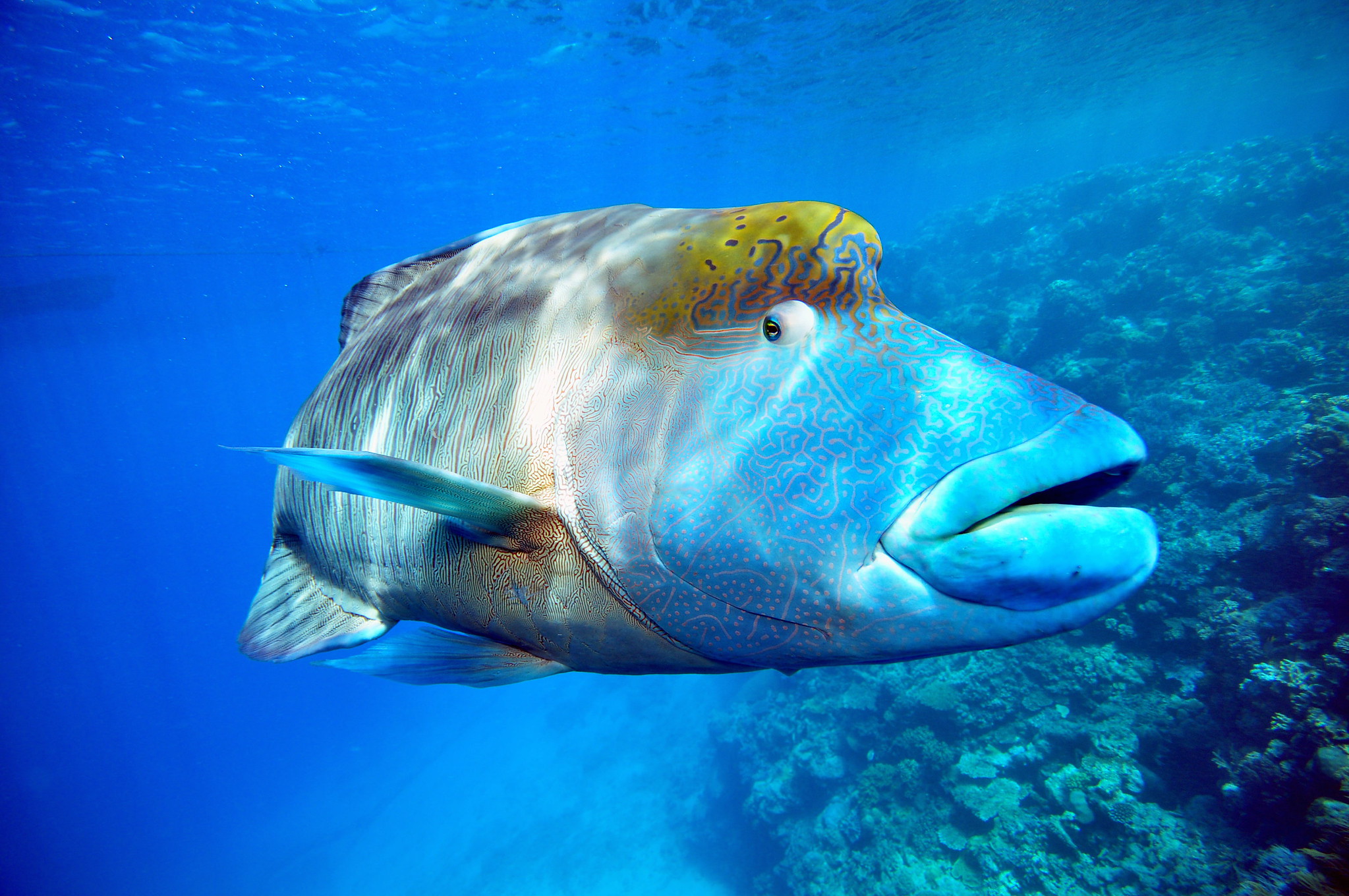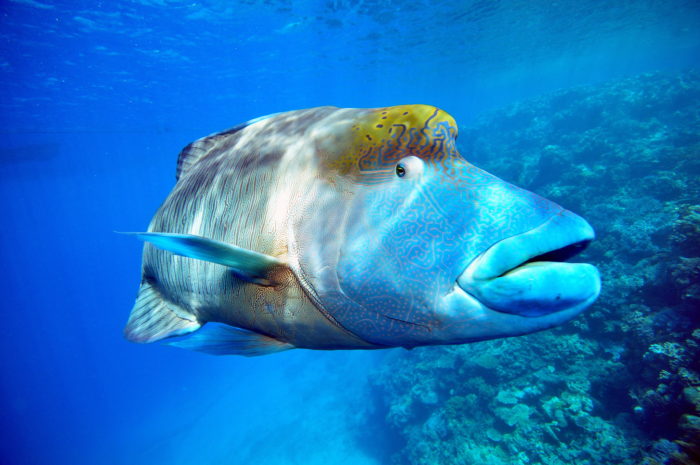
Sea Wonder: Humphead Wrasse

Photo credit: Larry Koester
Humphead wrasse (Cheilinus undulatus) are one of the largest reef fish in the world’s ocean, reaching lengths of seven feet and weighing more than 420 pounds — and those are just the largest individuals we’ve seen and recorded! They get their name from the bulbous hump atop their heads and are sometimes called “the king of the coral reef”. In many areas of the Indo-Pacific ocean, these fish are of traditional significance, long used in ceremonies in Fiji, Palau, and other island nations. They are also highly valued reef fish, seen as a luxury live fish for the aquarium trade or as an exotic dining option throughout Asia.
DESCRIPTION
Humphead wrasse are large fish with distinct lips that appear thick and full, a rounded tail fin, and a large, bulbous forehead hump that becomes more pronounced as the fish get older. Their coloration is distinct and changes throughout their lifetimes. Males can be a blend of bright electric blue, green, or light purple all over, and juveniles and females are usually red-orange with whiter bellies. Also developing with age are squiggly patterns near the face that resemble the facial tattoos of the Maori people, which earns this fish another nickname, the Maori wrasse.
DIET & HABITAT
Humphead wrasse eat hard-shelled invertebrates like mollusks, crustaceans, and echinoderms. They play an important role in their reef ecosystems by eating animals that eat hard corals, notable the crown of thorns starfish, which can destroy reefs at a rapid pace. Humphead wrasse use their rough teeth that are fused together like a beak to pierce through shells or break animals away from corals, rocks, and other fixed structures. To reveal hidden prey, these fish can bite off coral branches or blow jets of water from their mouths to disturb sediment on the seafloor and reveal buried morsels. A second set of teeth in the wrasse’s throat, called pharyngeal teeth, help the fish to grind and crush their prey. Potential predators of the humphead wrasse are larger reef fish, including sharks.
Humphead wrasse live throughout the Indo-Pacific Ocean, including in American Samoa. In the National Marine Sanctuary System, we see them in and near Rose Atoll Marine National Monument and National Marine Sanctuary of American Samoa. Adults prefer the outer slops and steep drop offs near a reef community, which juveniles live in the reef, especially among the thickets of living staghorn corals, which provide them hiding places and physical protection from potential predators. They are diurnal fishes, meaning they are active during the day and rest in reef caves and under coral ledges at night.
LIFE HISTORY
Humphead wrasse lead mostly solitary lives, though we do see male-female pairs or small social groupings comprised of a male, several smaller adults of mixed sexes, and several juveniles. The species is a protogynous hermaphrodite, which means they can change sex throughout their lifetimes depending on environmental and social conditions. Currently, scientists believe the transition only involves changes from female to male, which occurs at around nine years old. This adaptive feature ensures there is always a male available to mate with sexually mature females. As far as we know, individual wrasse that were born male remain male throughout their lifetimes. Females that transition can become “supermales”, which are larger than other males and have distinctly brighter colors and more pronounced patterns on its skin, which ecologists believe attracts females to the supermale.
Humphead wrasse can live 30 years or more, reaching adulthood and sexual maturity at around five or seven years old, whenever they reach their full body size. Spawning events occur at certain times of the year, generally times when water temperatures are just right and food is plentiful. A hundred or more individuals can gather for spawning events, which involve males and females releasing gametes into the water column, where they fuse and fertilize. The eggs hatch soon after and larval wrasse settle in or very close to the reef where they begin to eat and grow. Wrasse do not provide parental investment after their eggs hatch and most larval wrasse don’t survive to reach their juvenile life stage because of predation by larger animals.
THREATS & CONSERVATION
The IUCN lists the humphead wrasse as endangered, the U.S. National Marine Fisheries Service lists it a Species of Concern, and it is listed on CITES’ Appendix II. The species is now rare in its native habitat due to slow reproductive rates and diminishing spawning sites, making them vulnerable to overfishing. Humphead wrasse populations have decreased by 50 percent or more over the past three decades due to illegal fishing, habitat loss and degradation, spearfishing along reefs, and climate change effects. The humphead wrasse is a common site in aquarium facilities and it is considered a highly important tourism species in Indo-Pacific reefs frequented by divers. Aquarium breeding programs and conservation programs can help prevent further population decline and help this reef fish recover.
